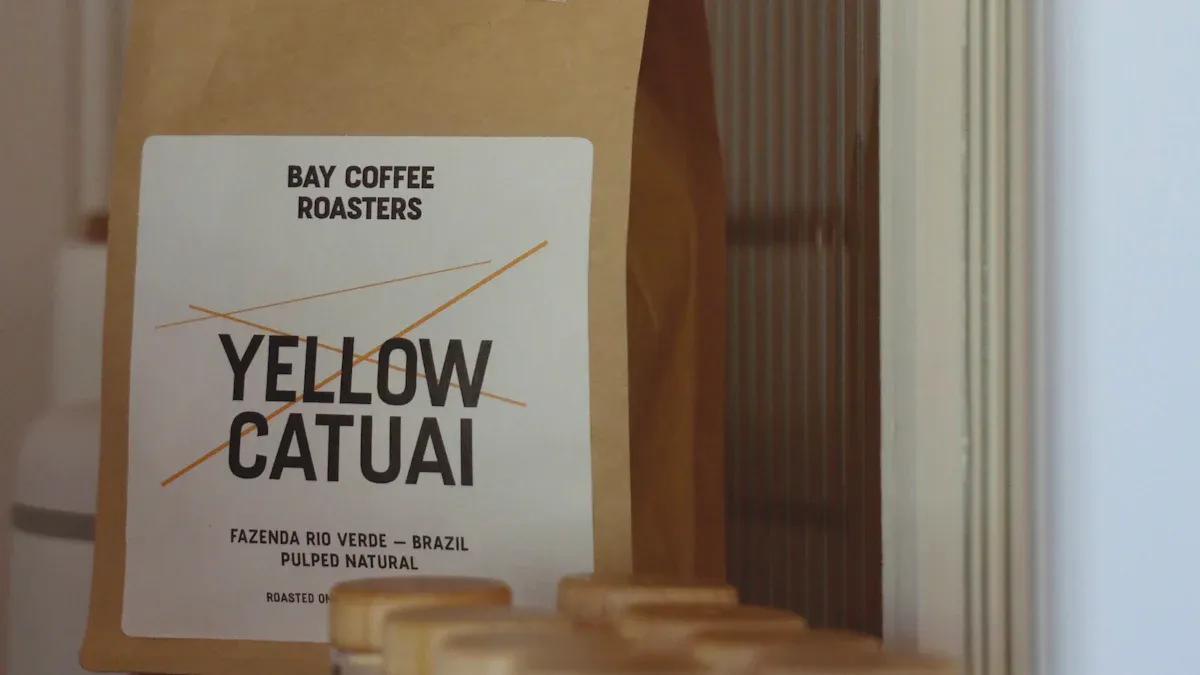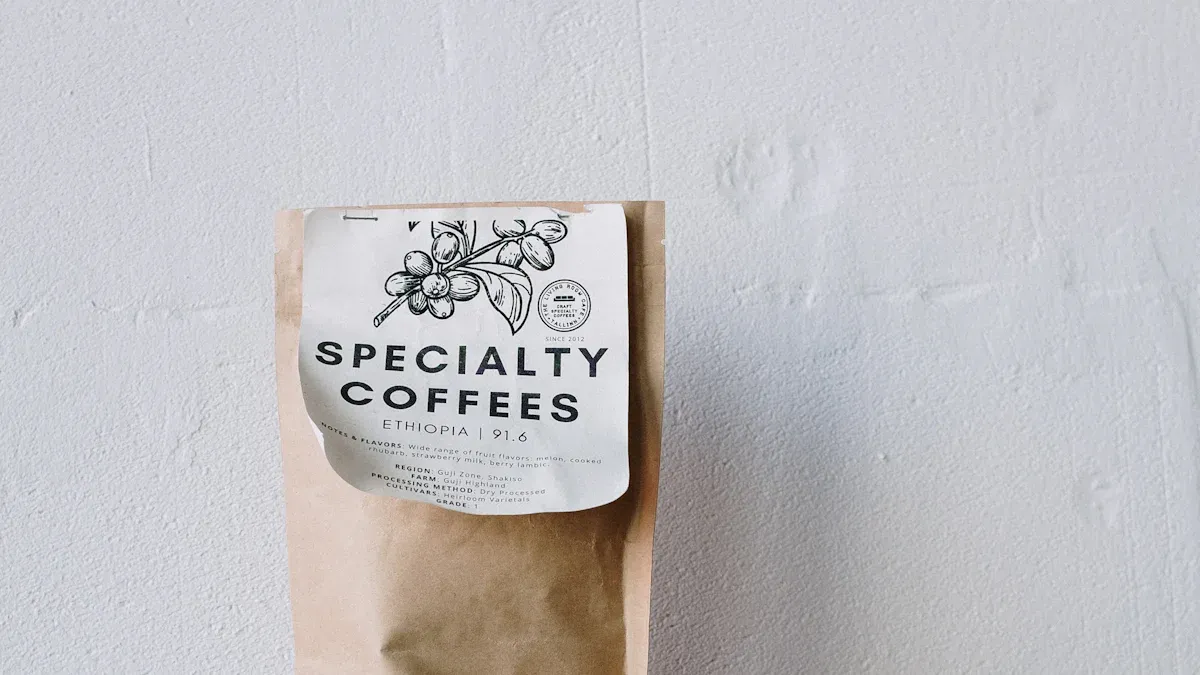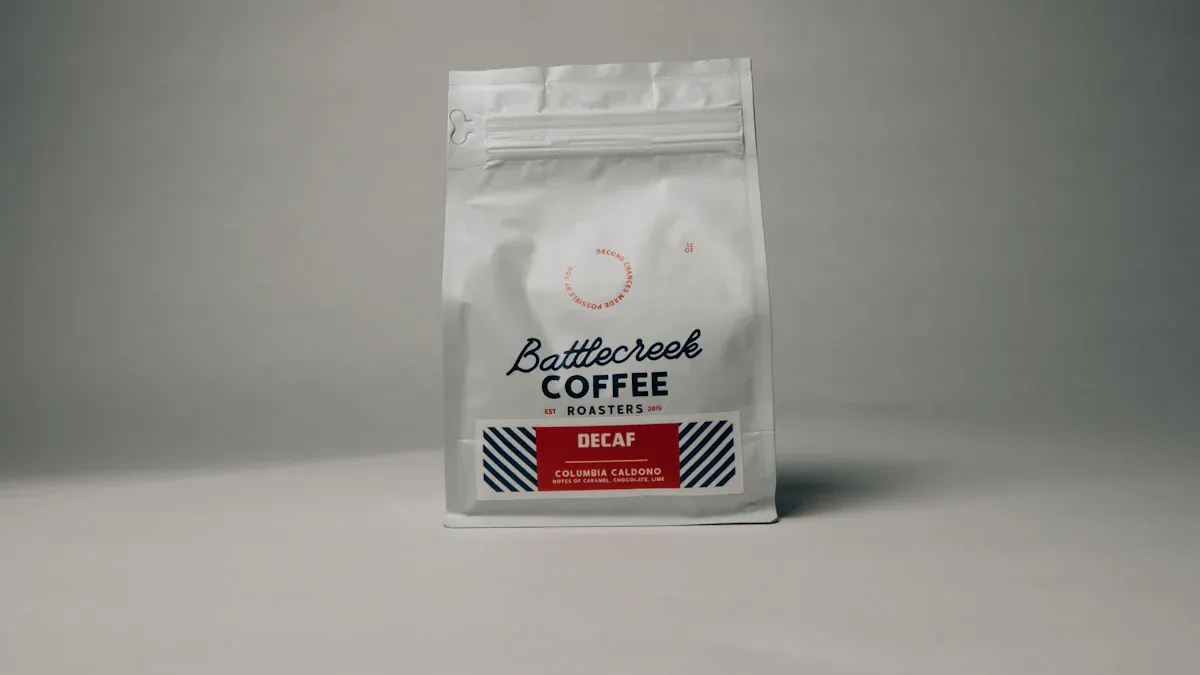
When creating custom made coffee bags, the text should be balanced. Too much text can confuse people, but too little leaves questions. Be clear. Add only important details, like product info and your brand. Keep the design simple and easy to read. Your custom made coffee bag should catch attention and build trust quickly. Short text makes the bag useful and nice to look at.
Essential Information for Custom Made Coffee Bags
When designing custom made coffee bags, you need to include key details that help customers understand your product. These details not only provide essential information but also build trust and make your coffee stand out. Let’s break down the must-have elements.
Coffee Type and Roast Level
One of the first things coffee lovers look for is the type of coffee and its roast level. Is it Arabica or Robusta? Is it a light, medium, or dark roast? This information helps customers decide if your coffee matches their taste preferences. For example, a light roast might appeal to someone who enjoys a mild, fruity flavor, while a dark roast could attract those who prefer a bold, rich taste.
You can make this detail pop by placing it near the top of the bag or close to your logo. Use clear and simple language, like “100% Arabica – Medium Roast.” This way, customers can spot it at a glance.
Weight and Net Content
The weight of the coffee is another crucial piece of information. It tells customers how much coffee they’re getting for their money. Whether it’s a 12-ounce bag or a 1-kilogram package, this detail helps set expectations and ensures transparency.
Place the weight on the front of the bag, usually near the bottom. Use a font size that’s easy to read but doesn’t overpower other elements. For example:
12 oz (340 g)
1 lb (454 g)
This small detail can make a big difference in how professional your packaging looks.
Expiration Date or Best By Date
Freshness matters when it comes to coffee. Including an expiration date or a “best by” date shows customers that you care about quality. It also helps them know how long they can enjoy your coffee at its peak flavor.
You can print this date on the back of the bag or near the bottom seam. Make sure it’s easy to find but doesn’t distract from the overall design. A simple format like “Best By: MM/DD/YYYY” works perfectly. If your coffee is freshly roasted, you might also want to include the roast date. This adds an extra layer of transparency and appeals to coffee enthusiasts who value freshness.
Pro Tip: If your coffee is vacuum-sealed or packed with a one-way valve, mention it! This reassures customers that your packaging keeps the coffee fresh.
Contact Information (e.g., website, social media, or address)
Your coffee bag is more than packaging. It’s a way to connect. Adding contact details helps people learn about your brand. They can ask questions or share their thoughts about your coffee. Think of it as starting a conversation.
Here’s what to include:
Website: Your website is your business’s main hub. Customers can see products, read your story, and order coffee. Keep the URL short and easy to remember. For example, “www.yourbrandcoffee.com” is better than a long one. Place it near the bottom or next to your logo.
Social Media Handles: Social media helps your brand stand out. Add Instagram, Facebook, or Twitter handles to the bag. This lets customers follow you for updates and deals. Use icons to make it look nice, like:
Follow us: @YourBrandCoffeeEmail Address: Some people like direct contact. Adding an email shows you’re friendly and ready to help. Keep it simple, like “info@yourbrandcoffee.com.”
Physical Address: If you have a café or roastery, include the location. This can bring in local customers. It also shows there’s a real place behind your brand.
Tip: QR codes are a smart way to share all this info. Customers can scan to visit your website, follow social media, or watch a coffee video.
Keep contact details neat and tidy. Don’t clutter the design. A small section on the back works well. This keeps your custom made coffee bags clean and professional but still helpful.
Branding and Marketing Text for Coffee Bags

Brand Name and Logo
Your brand name and logo show what your coffee is about. They are the first things people notice on your coffee bag. A strong logo and clear name make your product easy to remember. Research shows coffee bags affect how shoppers feel about your product. Here’s why your brand name and logo matter:
Coffee bags change how people view your product.
A good logo and matching colors make your bag stand out.
Clear branding builds trust and helps people buy again.
Put your logo at the top of the bag where it’s easy to see. Keep the design simple and neat. If your brand name is special, make it bold and readable. This makes your coffee bag look professional and attractive.
Tagline or Slogan
A fun tagline or slogan can make your coffee brand memorable. It quickly tells people what your coffee is all about. A good slogan sticks in people’s minds and makes your brand relatable. For example, Two Chimps Coffee uses “Awesome Coffee. No Nonsense.” It shows their style and connects with customers.
Brand | Slogan | Why It Works |
|---|---|---|
Two Chimps Coffee | Awesome Coffee. No Nonsense. | The slogan shows the brand’s personality and builds recognition. |
Think about what makes your coffee special. Is it the taste? The way it’s made? Your values? Use this to create a short, catchy phrase. Put the tagline near your logo or at the top of the bag. This helps grab attention fast.
Unique Selling Points (e.g., organic, fair trade, single-origin)
What makes your coffee stand out? Sharing your unique selling points (USPs) helps customers pick your coffee over others. Maybe your coffee is organic, fair trade, or single-origin. These details are important to shoppers who care about quality and the planet.
Here are some examples of USPs:
Organic: Tell customers your coffee is grown without harmful chemicals.
Fair Trade: Show you support fair pay and ethical farming practices.
Single-Origin: Highlight the special flavors from one coffee-growing region.
Put these details on the front of the bag near the coffee type or roast level. Use small icons or badges to make them easy to spot. For example, a “USDA Organic” logo can catch attention quickly. These points add value to your coffee and build trust with buyers.
Awards or Recognitions (if applicable)
Have you seen how awards catch your eye? Adding awards or certifications to your custom made coffee bags can do the same. It’s like giving your coffee a special badge that says, “Try me!”
If your coffee has won awards or earned certifications, show them off. These honors tell buyers your coffee is high-quality, tasty, or eco-friendly. For example, if the Specialty Coffee Association recognized your coffee or it won “Best Coffee,” mention it. Awards like these build trust and make your brand believable.
Here’s how to display them well:
Use Icons or Badges: Small icons or badges make awards pop. A gold medal icon with “Award-Winning Coffee” quickly shows quality.
Keep It Simple: Don’t write too much. Say “Voted Best Coffee 2023” or “Certified Fair Trade.”
Placement Matters: Put awards near the top or by your logo. This makes them easy to spot.
Tip: If you have many awards, use a list or table to show them neatly. For example:
Gold Medal – International Coffee Awards 2023
Certified Organic – USDA
Best Single-Origin Coffee – Coffee Lovers’ Choice 2022
Awards make your coffee look fancy and help it stand out. They’re like a stamp of approval that tells customers they’re picking something great.
Optional Text Elements for Custom Coffee Bags
Brewing Instructions
Adding brewing steps to your coffee bag helps customers. Some people don’t know the best way to make coffee. A simple guide can improve their experience. Include steps for popular methods like pour-over or French press. For example:
Pour-Over: Use 1 tablespoon of coffee for 6 ounces of water. Heat water to 200°F and pour slowly in circles.
French Press: Add 2 tablespoons of coffee for 8 ounces of water. Steep for 4 minutes, then press.
Keep the steps short and easy to read. Place them on the back or bottom of the bag. This small detail shows you care about your customers and makes your coffee easier to enjoy.
Coffee Origin Story
Telling your coffee’s story helps connect with customers. People like knowing where their coffee comes from. Share details about the farmers, the region, or how the beans were grown. A short story makes your brand special and easy to remember.
Why is this important?
Stories create emotional bonds.
Personal details build loyalty.
Younger buyers enjoy meaningful stories.
You don’t need to write a lot. A few sentences about the coffee’s journey are enough. Put this story on the back or near the bottom of the bag. It’s a great way to make your coffee stand out.
Certifications (e.g., USDA Organic, Rainforest Alliance)
Certifications make your coffee more trustworthy. Labels like USDA Organic or Rainforest Alliance show your coffee meets high standards. But make sure these certifications are real. Fake labels can hurt trust.
If your coffee is certified, show the logo on the front of the bag. Use small icons to keep the design neat. For example, a USDA Organic seal or Rainforest Alliance frog logo grabs attention. These labels show your coffee supports fair pay or the environment.
Tip: If your coffee isn’t certified but follows eco-friendly practices, say so. Being honest builds trust and shows you care.
Customer Engagement Text (e.g., hashtags, QR codes)
Want to connect with customers outside the store? Adding simple engagement tools to your coffee bags can help. Things like hashtags or QR codes make your brand more interactive.
Hashtags That Get People Talking
Hashtags are a fun way to involve customers. They let people share their coffee moments online, boosting your brand’s reach. For example, you could use hashtags like #BrewWithYourBrand or #MorningWithYourCoffee. These make it easy for customers to tag your coffee in posts or reviews.
Tip: Use short, easy-to-remember hashtags. Long ones might confuse people.
QR Codes for Quick Access
QR codes are like shortcuts to your brand’s content. When scanned, they can lead to your website, brewing tips, or a video about your coffee. It’s a fast way to share more details with customers.
Here’s how to use QR codes well:
Link to a “How to Brew” guide for your coffee.
Send customers to your online store for quick reorders.
Share a video showing how your coffee is made.
Place the QR code on the back or near contact info. Make it big enough to scan but not too distracting.
Pro Tip: Always test your QR code before printing to ensure it works.
By using hashtags and QR codes, you’re doing more than selling coffee. You’re building a community of coffee fans who feel connected to your brand. This turns your coffee bag into a smart marketing tool.
Design and Layout Tips for Custom Made Coffee Bags

Make It Easy to Read
Your coffee bag should be simple to read quickly. Shoppers often decide fast, so clear text helps. Use fonts that are easy to see and understand. Avoid fancy or hard-to-read styles. Pick font sizes that are big enough to notice but not too large.
Contrast is very important. Dark text on a light background works well. For example, if your bag is dark brown, use white or cream text. Keep sentences short and simple. Instead of writing, “This coffee is made from beans grown in Ethiopia’s highlands,” say, “Ethiopian Highland Coffee.” It’s faster to read and clear.
Tip: Ask friends to test your design. If they struggle to read it, simplify it.
Organize Text by Importance
Not all text on your bag is equally important. Use size and placement to show what matters most. Start with your brand name and logo at the top. These should be bold and easy to see. Below that, add the coffee type and roast level in a slightly smaller size. Put details like weight, expiration date, and contact info near the bottom.
Some brands keep designs simple to highlight key info. For example, SEY Coffee puts its mission in the spotlight. Onyx Coffee Lab uses bold headings and smaller subtext for balance. Follow these ideas to make your coffee bag look neat and useful.
Pro Tip: Use bold fonts for main details and lighter fonts for extra info.
Use Empty Space Wisely
Empty space, or white space, makes your design look clean. It helps text and images stand out. A crowded design can confuse shoppers and look messy.
Think of white space as breathing room for your bag. For example, leave space around your logo before adding other text. This makes each part easier to notice. Don’t feel like you need to fill every spot with text or pictures. Sometimes, less is better.
Tip: Use white space to highlight key parts. A logo with space around it can grab attention better than a busy design.
Match Text Style with Brand Identity
The way your coffee bag’s text looks should match your brand. It’s not just about the words but how they appear. Fonts, tone, and layout work together to tell your story. When these match your brand identity, it creates a look people trust and remember.
Think about your brand’s vibe. Is it bold and exciting? Or is it fancy and classy? Your text style should show that. For example, a clean, modern font fits a high-end coffee brand. A fun, handwritten font works for a creative, small roaster.
Why does matching text style matter?
It keeps your look the same everywhere, like on your website.
It helps people know your brand right away.
It shows you care about details, which builds trust.
Tip: Use a style guide to pick fonts and tones that fit your brand. If you don’t have one, make one! It helps keep your design consistent.
Great brands use these ideas to shape how people see them. They pick fonts and tones that create a strong, unified look. This makes their products stand out and keeps customers coming back.
When designing your coffee bag, keep the text clear and easy to read. Don’t use fancy fonts that are hard to understand. Focus on making it simple but full of personality. A good text style doesn’t just look nice—it shows customers who you are.
Making great custom coffee bags means finding the right balance. Add enough details to inform and attract, but not too much. Simple, clear text with a smart design makes your bag useful and nice to look at. Focus on the key details to share your brand’s story and values. Remember, less is more—keep it neat, easy to read, and customer-friendly.
FAQ
How much text is too much for a coffee bag?
Too much text makes your bag look cluttered and hard to read. Stick to the essentials like coffee type, weight, and branding. Keep it simple and visually balanced. Less is more when it comes to grabbing attention quickly.
Should I include brewing instructions on my coffee bag?
Yes, if you want to help customers enjoy your coffee better. A short guide for popular methods like pour-over or French press adds value. Place it on the back or bottom of the bag to keep the design clean.
What’s the best way to highlight my brand name?
Put your brand name at the top of the bag in bold, readable text. Pair it with your logo for instant recognition. Use colors and fonts that match your brand’s personality to make it stand out.
Are certifications important for coffee bags?
Certifications like USDA Organic or Fair Trade build trust and show quality. If your coffee meets these standards, display the logos on the front. They attract eco-conscious buyers and make your product more credible.
Can QR codes help my coffee bag stand out?
Absolutely! QR codes let customers access extra info like brewing tips or your online store. Place them near contact details or on the back. Make sure they’re easy to scan and lead to useful content.